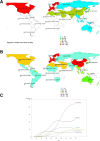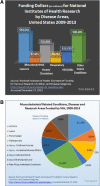Strategies for optimising musculoskeletal health in the 21st century
- PMID: 30971232
- PMCID: PMC6458786
- DOI: 10.1186/s12891-019-2510-7
Strategies for optimising musculoskeletal health in the 21st century
Abstract
We live in a world with an ever-increasing ageing population. Studying healthy ageing and reducing the socioeconomic impact of age-related diseases is a key research priority for the industrialised and developing countries, along with a better mechanistic understanding of the physiology and pathophysiology of ageing that occurs in a number of age-related musculoskeletal disorders. Arthritis and musculoskeletal disorders constitute a major cause of disability and morbidity globally and result in enormous costs for our health and social-care systems.By gaining a better understanding of healthy musculoskeletal ageing and the risk factors associated with premature ageing and senescence, we can provide better care and develop new and better-targeted therapies for common musculoskeletal disorders. This review is the outcome of a two-day multidisciplinary, international workshop sponsored by the Institute of Advanced Studies entitled "Musculoskeletal Health in the 21st Century" and held at the University of Surrey from 30th June-1st July 2015.The aim of this narrative review is to summarise current knowledge of musculoskeletal health, ageing and disease and highlight strategies for prevention and reducing the impact of common musculoskeletal diseases.
Keywords: Ageing; Global burden; Joint diseases; Low back pain (LBP); Metabolic disease; Musculoskeletal disorders; Musculoskeletal health; Obesity; Osteoarthritis (OA); Osteoporosis (OP); Rheumatoid arthritis (RA); Sarcopenia; Type II diabetes.
Conflict of interest statement
Ethics approval and consent to participate
Not applicable.
Consent for publication
Not applicable.
Competing interests
The authors wrote this paper within the scope of their academic and affiliated research positions. The authors declare no conflict of interests.
Publisher’s Note
Springer Nature remains neutral with regard to jurisdictional claims in published maps and institutional affiliations.
Figures



References
-
- Age UK. Later Life in the United Kingdom. 2018. http://www.ageuk.org.uk/Documents/EN-GB/Factsheets/Later_Life_UK_factshe....
-
- Policy paper. Long term conditions compendium of information: Third Edition. 2012. https://assets.publishing.service.gov.uk/government/uploads/system/uploa....
-
- Cross M, Smith E, Hoy D, Nolte S, Ackerman I, Fransen M, Bridgett L, Williams S, Guillemin F, Hill CL, et al. The global burden of hip and knee osteoarthritis: estimates from the global burden of disease 2010 study. Ann Rheum Dis. 2014;73(7):1323–1330. - PubMed
-
- Hoy DG, Smith E, Cross M, Sanchez-Riera L, Buchbinder R, Blyth FM, Brooks P, Woolf AD, Osborne RH, Fransen M, et al. The global burden of musculoskeletal conditions for 2010: an overview of methods. Ann Rheum Dis. 2014;73(6):982–989. - PubMed
-
- Woolf AD. The bone and joint decade. Strategies to reduce the burden of disease: the bone and joint monitor project. J Rheumatol Suppl. 2003;67:6–9. - PubMed
Publication types
MeSH terms
Grants and funding
LinkOut - more resources
Full Text Sources
Other Literature Sources
Medical
Miscellaneous

